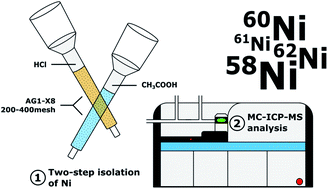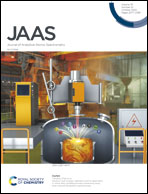Innovative two-step isolation of Ni prior to stable isotope ratio measurements by MC-ICP-MS: application to igneous geological reference materials
Abstract
Nickel stable isotope ratios have attracted a growing interest across the (bio)geochemical and environmental sciences since the late 2000s. Accuracy and precision of Multi-Collector Inductively Coupled-Plasma Mass Spectrometry (MC-ICP-MS) measurements depend crucially on efficient chemical purification of the target analyte to avoid spectral and non-spectral interferences and artificial on-column fractionation. In the case of Ni, this has been previously achieved by cumbersome chemical isolation protocols involving non-aqueous media, Ni-specific resin or complexing agent and up to five successive chromatographic columns. Since the advent of MC-ICP-MS, sample throughput in isotopic analysis has increased significantly, but the Ni isolation procedures do not allow for large numbers of samples to be processed. Advances in Ni isotope geochemistry have thus been relatively slow compared to those of other transition elements (e.g., Cu, Zn, Fe). Here, we present an innovative and straightforward two-step procedure for quantitative isolation of Ni from igneous silicate matrix prior to MC-ICP-MS analysis to help bridge that gap. Nickel is purified taking advantage of the selective adsorption of chemical elements from hydrochloric and acetic acids onto the widespread AG1-X8 (200–400 mesh) anion exchange resin, without using Ni-specific compounds nor pH-tuning. A single pass through the two successive columns results in a quantitative recovery (≥96%) of Ni as a pure Ni fraction, reducing preparation costs and time, eluent volumes and total procedural blank contribution (<0.25 ng). A set of 14 – both new and well-documented – igneous geological reference materials were processed and measured for their Ni isotopic composition using a Thermo Scientific™ Neptune™ MC-ICP-MS unit to consolidate and expand the pre-existing database of rock standards. All δ60/58Ni data reported as the per mille deviation of 60Ni/58Ni from the NIST SRM 986 standard obtained in our study are in excellent agreement with those previously documented, indicating accurate determination of Ni isotope ratios. The overall precision of our method is estimated to be ca. ±0.032‰ (2SD) on δ60/58Ni based on repeated analyses of the NIST SRM 986 and geological reference materials MUH-1 and JP-1.



 Please wait while we load your content...
Please wait while we load your content...